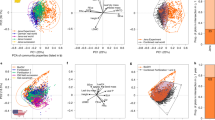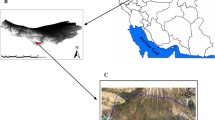Abstract
A constant ratio between species richness estimated at the local and regional scale is interpreted as a proof of quasi-neutral unsaturated communities. Based on Zobel’s model of plant community (Zobel,Folia Geobot. 36: 3–8, 2001) we tested the methodology of the species-pool concept by comparing the saturated and unsaturated communities generated by spatially-explicit mechanistic simulations with known assembly rules. Tests show that local-regional species plots can be applied to distinguish saturated vs. unsaturated communities, however, the outcome of tests, i.e. the relationship between local and regional richness depends on the size of the areas compared. Independently from the mechanisms controlling diversity, trivial saturation will appear if one of the scales is either too small or too broad because species-area curves are bound at these extreme scales. Similarly, trivial unsaturaton will appear if the two scales compared are close to each other. The application of species-area curves is useful because they help to find scales for non-trivial relationships.
Field tests reporting quasi-neutrality and unsaturated plant communities were performed at the intermediate scales of the corresponding species-area curves, and they were estimated from heterogeneous samples. Therefore, this field evidence might be biased by scaling artefacts. We propose to reanalyze the field evidence with solid scaling conventions and to restrict the concept of quasi-neutrality to subordinated functional groups based on the following hypotheses: (1) neutrality will appear within subordinated guilds as a consequence of the hierarchical structure of plant communities; (2) the lower a guild in the hierarchy the higher neutrality of within-layer processes detected; (3) quasi-neutrality found at the community level is not a proof of community-level neutrality but it is due to the higher number of subordinated species in the samples.
Similar content being viewed by others
References
Arrhenius O. (1921): Species and area.J. Ecol. 9: 95–99.
Bartha S. (1992): Preliminary scaling for multi-species coalitions in primary succession.Abstr. Bot. 16: 31–41.
Bartha S., Collins S.L., Glenn S.M. &Kertész M. (1995a): Fine-scale spatial organization of tallgrass prairie vegetation along a topographic gradient.Folia Geobot. Phytotax. 30: 169–184.
Bartha S., Czárán T. &Oborny B. (1995b): Spatial constraints masking community assembly rules: a simulation study.Folia Geobot. Phytotax. 30: 471–482.
Bartha S., Czárán T. &Podani J. (1998): Exploring plant community dynamics in abstract coenostate spaces.Abstr. Bot. 22: 49–66.
Bartha S., Pickett S.T.A. &Cadenasso M.L. (2000): Limitations to species coexistence in secondary succession. In:White P.S., Mucina L., Lepš J. &van der Marrel E. (eds.),Vegetation science in retrospect and perspective, Proceedings 41. IAVS Symposium Uppsala, Opulus Press, Uppsala, pp. 55–58.
Burke I.C., Lauenroth W.K., Vinton M.A., Hook P.B., Kelly R.H., Epstein H.E., Aguiar M.R., Robles M.D., Aguilera M.O., Murphy K.L. &Gill R.A. (1998): Plant-soil interactions in temperate grasslands.Biogeochemistry 42: 121–143.
Caley M.J. &Schluter D. (1997): The relationship between local and regional diversity.Ecology 78: 70–80.
Campetella G., Canullo R. &Bartha S. (1999): Fine-scale spatial pattern analysis of the herb layer of woodland vegetation using information theory.Pl. Biosystems, Giorn. Bot. Ital. 133: 277–288.
Cornell H. &Lawton J. (1992): Species interactions, local and regional processes, and limits to the richness of ecological communities: a theoretical perspective.J. Anim. Ecol. 61: 1–12.
Cornell H.V. &Karlson R.H. (1997): Local and regional processes as controls of species richness. In:Tilman D. &Kareiva P. (eds.),Spatial ecology, The role of space in population dynamics and interspecific interactions, Princeton University Press, Princeton, pp. 250–268.
Cresswell J.E., Vidal-Martinez V.M. &Crichton N.J. (1995): The investigation of saturation in the species richness of communities: some comments on methodology.Oikos 72: 301–304.
Czárán T. (1989): Coexistence of competing populations along an environmental gradient: a simulations study.Coenoses 2: 113–120.
Czárán T. (1998).Spatiotemporal models of population and community dynamics. Chapman & Hall, New York.
Czárán T. &Bartha S. (1989): The effect of spatial pattern on community dynamics: a comparison of simulated and field data.Vegetatio 83: 229–239.
Czárán T. &Bartha S. (1992): Spatiotemporal dynamics models of plant populations and communities.Trends Ecol. Evol. 7: 38–42.
Durett R. &Levin S.A. (1994): The importance of being discrete (and spatial).Theor. Popul. Biol. 46: 363–394.
Eriksson O. (1993): The species-pool hypothesis and plant community diversity.Oikos 68: 371–374.
Gosz J., Peters D., Kertész M., Kovács-Láng E., Kröel-Dulay GY &Bartha S. (2000): Organization of grasslands along ecological gradients: US-Hungarian LTER Grassland cooperation. InLajtha K. &Vanderbilt K. (eds.),Cooperation in long term ecological research in central and eastern Europe, Proceedings of the ILTER Regional Workshop, 22–25 June, 1999, Budapest, Hungary, Oregon State University, Corvallis, pp. 67–76.
Gotelli N.J. &Graves G.R. (1996):Null models in ecology. Smithsonian Institution Press, Washington
Hara T. (1993): Effects of variation in individual growth on plant species coexistence.J. Veg. Sci. 4: 409–416.
Herbent T. (1995): Founder and dominance control: neglected concepts in the community dynamics of clonal plants.Abstr. Bot. 19: 3–10.
Herben T. (2000): Correlation between richness per unit area and the species pool cannot be used to demonstrate the species pool effect.J. Veg. Sci. 11: 123–126.
Juhász-Nagy P. (1967): On some “characteristic area” of plant community stands. In:Proc. Colloq. Inf. Theory, Bolyai Math. Soc., Debrecen, pp. 269–282.
Juhász-Nagy P. (1984): Spatial dependence of plant populations. Part 2. A family of new models.Acta Bot. Acad. Sci. Hung. 30: 363–402.
Juhász-Nagy P. (1993): Notes on compositional diversity.Hydrobiologia 249: 173–182.
Juhäsz-Nagy P. &Podani J. (1983): Information theory methods for the study of spatial processes and succession.Vegetatio 51: 129–140.
Lawton J.H. (1999): Are there general laws in ecology?Oikos 84: 177–192.
Mucina L. &Bartha S. (1999): Variance in species richness and guild proportionality in two contrasting dry grassland communities.Biologia (Bratislava) 54: 67–75.
Pacala S.W. (1986): Neighborhood models of plant population dynamics, 4. single-species and multispecies models of annuals with dormant seeds.Amer. Naturalist 128: 859–878.
Palmer M.W. &White P.S. (1994): On the existence of ecological communities.J. Veg. Sci. 5: 279–282.
Palmer M.W. (2001): Extending the quasi-neutral concept.Folia Geobot. 36: 25–33.
Pärtel M., Zolbel M., Zobel K. &van der Marrel E. (1996): The species pool and its relation to species richness: evidence from Estonian plant communities.Oikos 75: 111–117.
Pickett S.T.A., Parker V.T. &Fiedler P. (1992): The new paradigm in ecology: Implications for conservation biology above the species level. In:Fiedler P. &Jain S. (eds.),Conservation biology: the theory and practice of nature conservation, preservation, and management, Chapman & Hall, Longon, pp. 65–88.
Ricklefs R.E. (1987): Community diversity: relative roles of local and regional processes.Science 235: 167–171.
Rydin H. &Barber K.E. (2001): Long-term and fine-scale coexistence of closely related species.Folia Geobot. 36: 53–61.
Silvertown J., Holtier S., Johnson J. &Dale P. (1992): Cellular automation models of interspecific competition for space — the effect of pattern on process.J. Ecol. 80: 527–534.
Srivastava D. (1999): Using local-regional richness plots to test species saturation: pitfalls and potentials.J. Anim. Ecol. 68: 1–16.
Szollát Gy. &Bartha S. (1991): Pattern analyses of dolomite grassland communities using information theory models.Abstr. Bot. 15: 47–60.
Tilman D. (1988):Plant strategies and the dynamics and structure of plant community. Princeton Univ. Press, Princeton.
Wilson J.B. (1999): Assembly rules in plant communities. In:Weiher E. &Keddy P. (eds.),Ecological assembly rules, Perspectives, advances, retreats, Cambridge University Press, Cambridge, pp. 130–164.
Wilson J.B. &Gitay H. (1995): Limitation to species coexistence: evidence for competition from field observations, using a patch model.J. Veg. Sci. 6: 369–376.
Winkler E. &Schmid B. (1995): Clonal strategies of herbaceous plant species: a simulation study on population growth and competition.Abstr. Bot. 19: 17–28.
Wu J. &Loucks O.L. (1995): From balance of nature to hierarchical patch dynamics: a paradigm shift in ecology.Quart. Rev. Biol. 70: 439–466.
Yodzis P. (1978):Competition for space and the structure of ecological communities. Lecture Notes in Biomathematics 25, Springer, Berlin.
Zobel M. (1997): The relative role of species pools in determining plant species richness: an alternative explanation of species coexistence?Trends Ecol. Evol. 12: 266–269.
Zobel K. (2001): On the species-pool hypothesis and on the quasi-neutral concept of plant community diversity.Folia Geobot. 36: 3–8.
Zobel K. &Liira J. (1997): A scale-independent approach to the richness vs. biomass relationship in ground-layer plant communities.Oikos 80: 325–332.
Author information
Authors and Affiliations
Corresponding author
Rights and permissions
About this article
Cite this article
Bartha, S., Ittzés, P. Local richness-species pool ratio: A consequence of the species-area relationship. Folia Geobot 36, 9–23 (2001). https://doi.org/10.1007/BF02803134
Issue Date:
DOI: https://doi.org/10.1007/BF02803134




